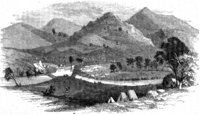Ophir, New South Wales
| Ophir New South Wales | |
|---|---|
| Coordinates | 33°7′42.3″S 149°14′34.3″E / 33.128417°S 149.242861°E |
| Population | 128 (SAL 2021)[1] |
| LGA(s) | Cabonne Shire Council |
Ophir is the name of a locality in New South Wales, Australia in Cabonne Shire.
History and discovery

Ophir is located near the Macquarie River northeast of the city of Orange. Ophir is the place where gold was first discovered in New South Wales in 1851, leading to the Australian gold rushes. In popular literature it has been stated that William Tom Jr, John Lister and Edward Hargraves found payable gold in February 1851 at the Ophir gold diggings, located at the confluence of Summer Hill Creek and Lewis Ponds Creek (33°10′7.68″S 149°14′19.68″E / 33.1688000°S 149.2388000°E). Hargraves was awarded £10,500 (worth $1,125,434 in 2004 values) by the NSW Government.
William Tom's father (Parson Tom)[2] named the area 'Ophir', after a region in the Old Testament noted for its fine gold.[3]
There was a gold rush to the area in 1851 and 1852. The village of Ophir was laid out in 1851 by Major Sir Thomas Livingstone Mitchell, its first lots were sold in 1852. Reef gold was discovered in 1868 by Joseph Christopherson.[4]
Although Hargraves was honoured and rewarded, it may have been William Tipple Smith mineralogist, who first discovered gold at what would be later named Ophir, in 1848. On 27 February 1852 William Tipple Smith wrote to geologist Sir Roderick Murchison in England saying the spot now called Ophir was the very spot where he had found nugget gold in 1848. Smith's claims and correspondence are exhaustively studied in a 1986 book "A Fool's Gold?" by Lynette Ramsay Silver, in the foreword of which geology Professor David Branagan of Sydney University concurs and states "It is good to see him deservedly remembered in the pages of this book".[5] William Tipple Smith was one of the owners of the Fitzroy Iron Works at Mittagong and, during a visit in February 1849, Governor Charles Augustus Fitz Roy was presented with a steel knife "mounted with colonial gold".[6]
Some remnants of old alluvial, reef, and deep lead mines, are located within the Ophir Reserve, which includes the former site of the town.[7] The town's cemetery also remains.[8] There is an obelisk that commemorates the discovery of payable gold, in 1851, giving credit to Edward Hargraves, John Lister, James Tom, and William Tom.[9]
All that remains of William Tipple Smith is one small gold sample and a previously unmarked grave (number 4929, section 4, Rookwood Cemetery) that was only recently provided with a headstone recognising him as the discoverer of the first payable gold in Australia.[10]
See also
- Australian gold rushes
- New South Wales gold rush
- Edward Hargraves
- Hargraves, New South Wales
- Hargraves House
References
- ^ Australian Bureau of Statistics (28 June 2022). "Ophir (suburb and locality)". Australian Census 2021 QuickStats. Retrieved 28 June 2022.
- ^ Long Gavin (2006). "William Tom (1791–1883)". Australian Dictionary of Biography . Retrieved 3 January 2025.
- ^ "Ophir". Sydney Morning Herald. 20 June 2008. Retrieved 3 June 2023.
- ^ "Photograph of gold discovery site of Ophir, near Orange, NSW". Powerhouse Museum. Retrieved 3 June 2023.
- ^ Silver, Lynette Ramsay, 1945- (1986). A fool's gold? : William Tipple Smith's challenge to the Hargraves myth. Jacaranda Press. ISBN 070161983X. OCLC 15053130.
{{cite book}}: CS1 maint: multiple names: authors list (link) CS1 maint: numeric names: authors list (link) - ^ "SYDNEY". Colonial Times (Hobart, Tas. : 1828 - 1857). 9 February 1849. p. 2. Retrieved 15 January 2019.
- ^ NSW Department of Customer Service, Transport for NSW (23 February 2023). "Ophir Reserve". NSW Government. Retrieved 26 June 2023.
- ^ "Australian Cemeteries Index - Ophir, NSW". austcemindex.com. Retrieved 26 June 2023.
- ^ "Gold Discovery Obelisk | Monument Australia". monumentaustralia.org.au. Retrieved 26 June 2023.
- ^ Power, Julie (3 September 2020). "History stands corrected: Smith, not Hargraves, first to discover gold in NSW". The Sydney Morning Herald. Retrieved 4 September 2020.

